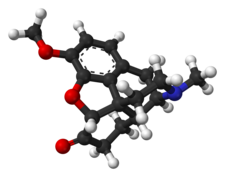 | |
 | |
| Clinical data | |
|---|---|
| Trade names | Hysingla ER, Zohydro ER |
| Other names | Dihydrocodeinone, hydrocodone bitartrate |
| AHFS/Drugs.com | Monograph |
| MedlinePlus | a601006 |
| License data |
|
| Dependence liability | High[1] |
| Addiction liability | High |
| Routes of administration | Clinical: By mouth[2] Others: Intranasal, rectal |
| Drug class | Opioid |
| ATC code | |
| Legal status | |
| Legal status |
|
| Pharmacokinetic data | |
| Bioavailability | Oral: 70%[4] |
| Protein binding | Low[4][5] |
| Metabolism | Liver: CYP3A4 (major), CYP2D6 (minor)[6] |
| Metabolites | • Norhydrocodone[6] • Hydromorphone[6] • Others[6] |
| Onset of action | 10–20 minutes[2] |
| Elimination half-life | Average: 3.8 hours[7] Range: 3.3–4.4 hours[2] |
| Duration of action | 4–8 hours[2] |
| Excretion | Urine[8][9] |
| Identifiers | |
| |
| CAS Number | |
| PubChem CID | |
| IUPHAR/BPS | |
| DrugBank | |
| ChemSpider | |
| UNII | |
| KEGG | |
| ChEBI | |
| ChEMBL | |
| CompTox Dashboard (EPA) | |
| ECHA InfoCard | 100.004.304 |
| Chemical and physical data | |
| Formula | C18H21NO3 |
| Molar mass | 299.370 g·mol−1 |
| 3D model (JSmol) | |
| |
| |
| (verify) | |
Hydrocodone, also known as dihydrocodeinone, is a semi-synthetic opioid used to treat pain and as a cough suppressant.[10] It is taken by mouth.[10] Typically, it is dispensed as the combination acetaminophen/hydrocodone or ibuprofen/hydrocodone for pain severe enough to require an opioid[11][12][13] and in combination with homatropine methylbromide to relieve cough.[10] It is also available by itself in a long-acting form sold under the brand name Zohydro ER, among others, to treat severe pain of a prolonged duration.[10][14] Hydrocodone is a controlled drug: in the United States, it is classified as a Schedule II Controlled Substance.
Common side effects include dizziness, sleepiness, nausea, and constipation.[10] Serious side effects may include low blood pressure, seizures, QT prolongation, respiratory depression, and serotonin syndrome.[10] Rapidly decreasing the dose may result in opioid withdrawal.[10] Use during pregnancy or breastfeeding is generally not recommended.[15] Hydrocodone is believed to work by activating opioid receptors, mainly in the brain and spinal cord.[10] Hydrocodone 10 mg is equivalent to about 10 mg of morphine by mouth.[16]
- ^ Bonewit-West K, Hunt SA, Applegate E (2012). Today's Medical Assistant: Clinical and Administrative Procedures. Elsevier Health Sciences. p. 571. ISBN 9781455701506. Archived from the original on 10 January 2023. Retrieved 20 August 2019.
- ^ a b c d Cite error: The named reference
ElliottSmith2016was invoked but never defined (see the help page). - ^ Anvisa (31 March 2023). "RDC Nº 784 - Listas de Substâncias Entorpecentes, Psicotrópicas, Precursoras e Outras sob Controle Especial" [Collegiate Board Resolution No. 784 - Lists of Narcotic, Psychotropic, Precursor, and Other Substances under Special Control] (in Brazilian Portuguese). Diário Oficial da União (published 4 April 2023). Archived from the original on 3 August 2023. Retrieved 16 August 2023.
- ^ a b Polsten GR, Wallace MS (21 June 2016). "Analgesic Agents in Rheumatic Disease". In Firestein GS, Budd R, Gabriel SE, McInnes IB, O'Dell JR (eds.). Kelley and Firestein's Textbook of Rheumatology. Elsevier Health Sciences. pp. 1081–. ISBN 978-0-323-41494-4. Archived from the original on 12 January 2023. Retrieved 23 September 2016.
- ^ Chabner BA, Longo DL (8 November 2010). "Chapter 37: Drug Therapy of Pain in Cancer Patients". Cancer Chemotherapy and Biotherapy: Principles and Practice. Lippincott Williams & Wilkins. pp. 700–. ISBN 978-1-60547-431-1. Archived from the original on 12 January 2023. Retrieved 23 September 2016.
- ^ a b c d Cite error: The named reference
Zhou2016was invoked but never defined (see the help page). - ^ Cite error: The named reference
DavisGlare2005was invoked but never defined (see the help page). - ^ Bluth MH (16 November 2016). Toxicology and Drug Testing, An Issue of Clinics in Laboratory Medicine, E-Book. Elsevier Health Sciences. pp. 85–. ISBN 978-0-323-47795-6. Archived from the original on 12 January 2023. Retrieved 22 June 2018.
- ^ Smith HS (21 February 2013). Opioid Therapy in the 21st Century. OUP USA. pp. 68–. ISBN 978-0-19-984497-5. Archived from the original on 12 January 2023. Retrieved 22 June 2018.
- ^ a b c d e f g h "Hydrocodone Bitartrate Monograph for Professionals". Drugs.com. American Society of Health-System Pharmacists. Archived from the original on 14 November 2010. Retrieved 15 April 2019.
- ^ Mallinckrodt (10 March 2021). "HYDROCODONE BITARTRATE AND ACETAMINOPHEN tablet (label)". National Institutes of Health DailyMed. Archived from the original on 6 November 2021. Retrieved 6 November 2021.
- ^ Briggs GG, Freeman RK, Yaffe SJ (2011). Drugs in Pregnancy and Lactation: A Reference Guide to Fetal and Neonatal Risk. Lippincott Williams & Wilkins. p. 692. ISBN 9781608317080.
- ^ "Hydrocodone Combination Products: MedlinePlus Drug Information". medlineplus.gov. Archived from the original on 5 July 2016. Retrieved 4 November 2023.
- ^ "Hydrocodone: MedlinePlus Drug Information". medlineplus.gov. Archived from the original on 15 April 2019. Retrieved 15 April 2019.
- ^ "Hydrocodone Use During Pregnancy". Drugs.com. Archived from the original on 28 January 2014. Retrieved 15 April 2019.
- ^ "Opioid Dose Calculator". Agency Medical Directors' Group. Archived from the original on 10 February 2016. Retrieved 15 April 2019.